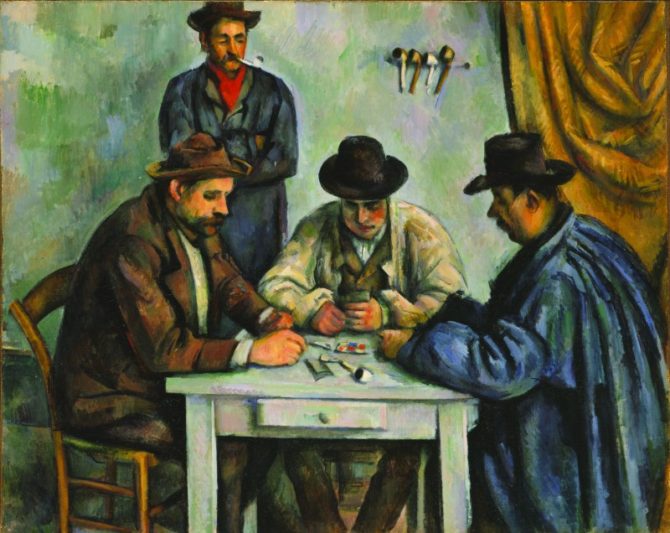This Way to the Cézannes

In 1996, the Philadelphia Museum of Art launched an exhibit simply titled Cézanne. Comprised of 170 works on loan from around the world, it was a critical and popular blockbuster, and became the standard-and the reference point-for curating Cézanne. Thirteen years later-and 103 years after Cézanne’s death at age 67-Philadelphia’s curators have done it again, with a dazzling show that juxtaposes 60 paintings, watercolors and sketches by Cézanne with works by artists who have cited him as a major influence, from Picasso to Mondrian.
Every artist to come after Cézanne, it seems, has said something definitive about him. The famous line “Cézanne is the father of us all,” has been attributed to both Picasso and Matisse. The American painter Jasper Johns (b. 1930) said of one particular painting by the post-Impressionist: “As for the Cézanne, it has a synesthetic quality that gives it great sensuality-it makes looking equivalent to touching.” Johns spent a lot of time thinking about Cézanne, studying him, and making use of the French painter’s technique in his own work again and again.
In the last room of the new exhibit Cezanne and Beyond, one of several versions of Johns’s Map of America hangs next to a Cézanne entitled Mont Sainte-Victoire. Cézanne was obsessed with Mont Sainte-Victoire, and, much as he did with his legendary still-lifes, used the mountaintop as a study in mastering form. Katherine Sachs, co-curator of the show with Joseph Rishel, described the map of America as Johns’s “own Mont Sainte-Victoire”; following Cézanne’s example (and Monet’s, with his cathedrals and haystacks), Johns painted his map over and over, using a single subject to explore the depth of his artistry.
One of the first portraits in the exhibit is 20th century American artist Marsden Hartley’s Canuck Yankee Lumberjack at Orchard Beach—a decidedly American painting, and determinedly Modernist. Next to it is Cézanne’s The Bather. Not only is the surface material similar in the two paintings—a strapping young man, naked but for small shorts—but the geometry is nearly identical, down to repeating diamond forms throughout, from the crooks of the two men’s arms to the shape of their nipples.
The almost slavish devotion of Hartley’s piece gives way to a kaleidoscope of tributes. Jeff Wall’s Card Players re-imagines Cézanne’s legendary piece of the same name through a photographer’s lens; Picasso, Braque and Leger turn the peaches, pears, tables and landscapes into a Cubistic mishmash of color, shape and texture; Matisse’s dancers leap off the walls. The effect is almost dizzying.
Perhaps the most delightful, and the most unexpected, works are by Abstract Expressionist and Post-Modernist artists. Jasper Johns’s The Drawer, a canvas in 3D with a drawer coming out of the wall; Ellsworth Kelly’s two enormous sculptures, one of water, one of the arches of a bridge reflected in water; Brice Marden’s vision of the sea as three bold stripes of color.
Joseph Rishel, co-curator of the exhibit, related a story to journalists about one of the contemporary artists in the exhibit, Belgian Francis Alys. While Alys was hanging his piece—an original Cézanne still—life covered in bubble wrap, the last piece in the show-he looked around the room, his eyes landing on a Mondrian, a Johns, a Cézanne, a Matisse. “I’ve got to stop doing these group shows,” he said, grinning. Though tongue-in-cheek, Alys’s comment resonates quite well with the exhibit’s intent. In announcing the show, Rishel stated its purpose as “first to display the continuing vitality of Cézanne as an artistic resource five generations on. Of equal importance in our endeavor is to illustrate the unfolding reality that a different Cézanne has evolved for each generation, defined by what artists have made of him and passed along to those who came after. It is a continuing story.”
Cézanne and Beyond is at the Philadelphia Museum of Art through May 17th. For more information, click here.
When you visit Philadelphia, be sure to visit the Barnes Foundation, home to the largest single collection of Cézanne paintings in the world. Find out more at the Barnes Foundation website.
The exhibit Picasso Cézanne runs from May 25-September 27, 2009 in Aix-en-Provence. website
Share to: Facebook Twitter LinkedIn Email
Leave a reply
Your email address will not be published. Required fields are marked *




REPLY